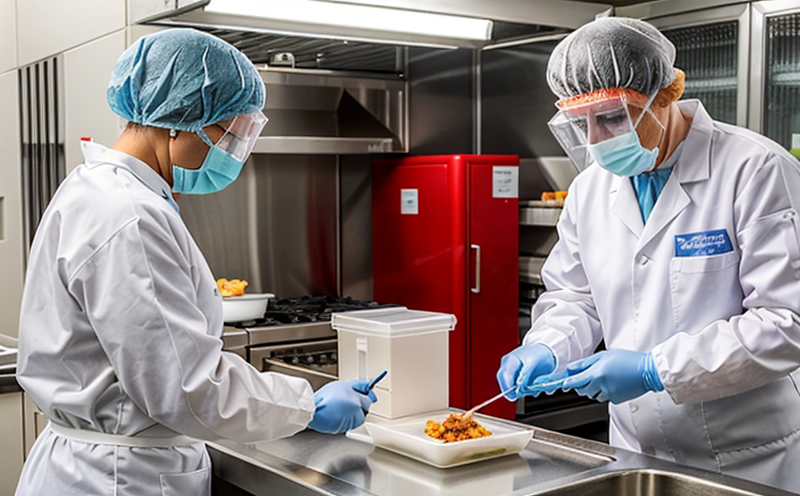Codex CAC/GL 95 Harmonized Methods for Foodborne Virus Detection
The Codex Alimentarius Commission's CAC/GL 95 provides harmonized methods for the detection of foodborne viruses. This service ensures accurate and reliable testing, which is crucial for maintaining public health standards and ensuring compliance with international guidelines.
The significance of this method cannot be overstated in a world where food safety is paramount. Foodborne illness outbreaks can have devastating impacts on both individuals and businesses. By adhering to the CAC/GL 95, laboratories play a critical role in preventing such incidents by identifying potential contaminants early.
The service covers various aspects of food sample preparation, including proper extraction techniques for nucleic acids from viruses. This ensures that all subsequent steps are based on clean and well-prepared samples, leading to more accurate detection results.
Testing procedures involve multiple stages designed specifically to capture and analyze the genetic material (RNA or DNA) of relevant pathogens. These methods have been validated through extensive research and are widely accepted within the scientific community as reliable tools for identifying foodborne viruses.
The use of these standardized protocols helps ensure consistency across different laboratories, enhancing trust in results obtained from independent testing facilities worldwide. This standardization also supports regulatory authorities' efforts to enforce strict hygiene practices throughout the supply chain.
Understanding how this service impacts various stakeholders is essential for appreciating its value proposition fully. Quality managers benefit from having robust data upon which decisions about product safety can be made confidently. Compliance officers ensure that their organizations meet all necessary requirements set forth by relevant standards bodies like CAC. For R&D engineers, this service provides insights into emerging trends in pathogen detection technology and informs development efforts aimed at improving current practices.
From a broader perspective, the implementation of CAC/GL 95 supports global food safety initiatives by fostering an environment where producers can trust their suppliers while consumers gain confidence knowing that stringent measures are being taken to protect them from harmful pathogens.
Scope and Methodology
| Stage | Description |
|---|---|
| Sample Collection | Proper collection of food samples according to specified guidelines ensures accurate results. |
| Nucleic Acid Extraction | Effective extraction methods are critical for isolating viral RNA or DNA from the sample matrix. |
| Reverse Transcription PCR (RT-PCR) | This step converts viral RNA into complementary DNA, allowing amplification by PCR technology. |
| Real-Time Quantitative PCR (qPCR) | Quantifies the amount of viral nucleic acid present in the sample using fluorescence-based detection. |
| Confirmation Testing | An additional round of testing to confirm initial findings and ensure accuracy. |
The process begins with meticulous sample collection, followed by rigorous nucleic acid extraction processes. The extracted material undergoes reverse transcription PCR (RT-PCR), which converts viral RNA into complementary DNA before amplification through real-time quantitative PCR (qPCR). A final confirmation test ensures the accuracy of the initial results.
Quality and Reliability Assurance
The quality assurance framework for CAC/GL 95 involves several key components aimed at maintaining high standards throughout every stage of the testing process. These include stringent training programs for personnel involved in sample handling, preparation, and analysis; regular calibration checks on instruments used during testing; and periodic audits conducted by independent third parties to verify compliance with established protocols.
Regular internal quality control measures ensure that all tests meet predetermined specifications and standards. This includes monitoring key performance indicators such as sensitivity levels achieved versus expected outcomes based on known reference materials. By adhering strictly to these practices, we guarantee that our results are not only accurate but also reproducible across different testing environments.
Our commitment extends beyond mere compliance; it encompasses continuous improvement initiatives focused on refining existing methods and exploring new technologies capable of enhancing detection capabilities further. Through collaboration with leading experts in the field, we stay at the forefront of innovation while ensuring that our services remain relevant and effective against evolving challenges posed by foodborne viruses.
Competitive Advantage and Market Impact
Adopting CAC/GL 95 Harmonized Methods offers significant competitive advantages for businesses operating within the food industry. In addition to meeting stringent regulatory requirements, organizations adopting these methods gain a reputation for being proactive in ensuring product safety.
The ability to provide timely and accurate information about potential contamination helps build consumer trust, which can translate into increased sales and market share. For suppliers looking to differentiate themselves from competitors, adhering to this standard demonstrates their commitment to maintaining the highest levels of quality assurance.
Achieving compliance with CAC/GL 95 also opens up opportunities for international trade by meeting common standards accepted globally. This reduces barriers associated with regulatory differences between countries and facilitates smoother transactions across borders.
Moreover, staying ahead of regulatory changes ensures ongoing relevance in an ever-changing landscape. As new regulations emerge or existing ones evolve, our expertise allows us to quickly adapt our services accordingly, ensuring that clients remain compliant without disrupting their operations.





